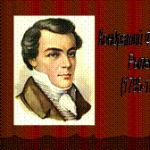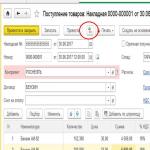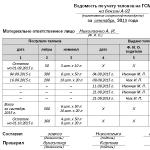Root- this is the main part of the word, carrying the main lexical meaning of the word. For words with the same root and names, this morpheme is common.
Cognates- these are words that have the same root. Similar words may refer to to different parts of speech:
AND to one part of speech:
reading - reader - reader.
Not related to words with the same root forms of the same word with changed endings.
Also, one should not confuse words with the same root and homonym words. In the latter, the roots look and read the same, but have completely different meanings:
Nose, nasopharynx - carry, sock.
The roots are:
Free;
Related.
Loose roots- these are roots that can fully exist in a language without additional morphemes. Roots that cannot exist not only without endings, but also other morphemes are called related.
One word can have two or more roots. Such words are called complex:
Water supply, stress-resistant, two meters.
Studying the spelling of such words Russian spelling.
Alternation in word roots.
Depending on changes in the form of the word, the root may occur alternation of sounds. Alternation is the replacement of sounds (one for another or others) in different forms of one word or in words with the same root, which is reflected in the spelling of the word.
It can happen in words alternation of vowels and consonants.
Vowel alternation.
o // amow - mow down
e // and erase - erase
e // o (e) sing - sing
a // in reap - reap
I // take them off - take them off
e // y (y) don’t care - I spit
ov // u poke - shove
e // zero sound day - day
o // zero sound sleep - sleep
and // th // pour it - pour it - pour it
and // th // oh drink - drink - sing
o // s // y dry - dry up - dryness
o // s // zero sound ambassador - send - send
Alternation of consonants.
b // bl love - love
p // pl beat - beat
m // ml feed - feed
in // ow catch - catch
c // h capital - capital
z // w narrow - narrower
t // with flowers - bloom
d // st sweet - sweets
t // to let - let
x // w deaf - wilderness
st // sch thick - thick
t // h // sh shine - candle - lighting
s // w high - higher
d // f // railway drive - drive - driving
k // h // c fist - kulachishche - kulak
g // f // z friend - to be friends - friends
In order to find words with the same root, it is necessary to compare several cognate words.
Morphemics is one of the most difficult topics for a child. Not every student can correctly divide a word into parts. However, the ability to correctly identify parts of a word is a necessary condition for mastering a number of rules of Russian spelling.
Russian language: what is the root of a word
A morpheme is a significant part of a word. First, during morphemic analysis, the stem and ending are isolated. The stem is the unchangeable part of the word, and the ending is changeable and indicates the form of the word. For example, in the word “cows,” cows are the stem, and y is the ending. The basis of a word includes the following parts of the word (morphemes) - prefix, root, ending. An important morpheme, denoted by an arc when parsing a word, is the root of the word.
What is the root word? The root of a word is the common part of related words. What words are called cognates? Words with the same root are based on one root, but other morphemes are different. For example, tall - height, leaf - foliage, dad - daddy, sister - sister.
How to find words with the same root
- There are words that have the same roots, but are not the same root. Thus, in the adjectives “peaceful” and “global” one can distinguish the root -peace-, but the words will not have the same root, since in the first case the adjective is formed from the word “peace” in the meaning “without war”, and in the second - in the meaning “ what’s around, the universe.” Lexical differences between words cannot make words have the same root.
- You should not mix words with the same root and forms of the same word. For example, the words “carrot” and “carrot” are cognates, and “carrot” and “carrots” are word forms of the word “carrot”.
- Words with the same root do not necessarily belong to the same part of speech. So, if “carrot” and “carrot” are nouns, then “run” and “run” are a noun and a verb, and “fun” and “cheerful” are an adverb and an adjective.
- Don't forget that in addition to the root, the word has prefixes and suffixes. If you can highlight them, then finding words with the same root will be much easier. For example, the word "chin". It contains the prefix sub-, the suffix -ok and the root -borod-. Thus, now you can choose the same root words: bearded, beard, beardless.
- Difficulties may arise due to historical consonant alternations. Externally, the roots are different, but the meaning remains the same. The fact is that previously the sound of Russian speech was different from what can be heard today. Due to historical changes in the sound structure of a language, the same root may sound differently in different words.
Some examples:
- k-ch": ruk/a - ruch"/k/a
- k-ts-ch": l"ik/ - l"its/o - l"ich"/n/y
- Ms: nog/a - knife/k/a
- g-z-z: friend/ - friend/i/t" - friend"/ya
- x-sh: uh/o- ush/i
Although the final consonants in the roots are different, the presented pairs of words are cognate.
What is a root spelling?
Why do you even need to isolate the root of a word and look for words with the same root? The fact is that one of the basic principles of Russian orthography (spelling) is the morphemic principle. It manifests itself, for example, in the rule “Unstressed vowel at the root of a word” or in the rule “Unpronounceable consonant at the root of a word.”
In the first case, you need to find a word with the same root so that the vowel being tested is stressed. For example, v_dyanoy means water, s_stra means sisterly, d_lovoy means business.
In the second case, you need to find a word so that the unpronounceable consonant is clearly audible. For example, garlic is honor, crunchy is crunch.
Not only in these cases is it worth remembering what the root of the word is. Another important rule is based on the ability to isolate the root.
Vowel alternation in the root
Due to the same historical reasons, different vowels are written in some words with the same root. For example, in roots with alternating vowels e-i (-ber- -bir-, -per- - pir-, -mer- - world-, -steel- -steel, -der- -dir, etc.) the letter "i" " is written only when the root is followed by the suffix -a-, for example: to die - to die, to spread - to spread, to tear apart - to tear apart, to shine - to shine.
Alternating roots also include:
lag-lozh, kas-kos, plav-pilaf, clan-clone, tvar-tvor, mak-mok, gar-gor, zar-zor, jump-skoch, equal-level, rast-ros-rasch.
What does morphemics study?
Morphemics is a branch of the science of language in which the composition (structure) of a word is studied. See: How to parse a word by its composition?
What is a morpheme?
Each word can be divided into small important parts called morphemes.
What are the parts of a word (types of morphemes)?
For example, the word submariner consists of 4 morphemes:
All morphemes, not counting the root, are called affixes, or service morphemes. See: What are derivational affixes?
What conventional signs indicate parts of a word (morphemes)?
Each of the morphemes has its own conventional signs:
See Plan for analyzing words by composition.
What is a word base and ending? How to find the base of a word and its ending?
Note. In this answer, the null ending is indicated by " Ο
", the base is underlined (in the absence of the technical ability to indicate them, as is customary in
linguistics).
Note. Difficulties are caused by identifying the base in words with final vowels I, e, e, yu , standing after other vowels or after a soft sign, because these vowels denote two sounds, one of which belongs to the base, and the other to the ending. For example, a noun army [armyj- A] has the ending -a, and the sound [j] goes into the base. In order to prove this, it is necessary to inflect the word: in the army,army[j- uh] th etc. In all these forms [j] is preserved. This means [ j ] is part of the base, since the ending is a differentiable part of the word. Exclusively in the form of the genitive case, this sound is graphically expressed using the letter th ( armies Ο ), and in other forms it does not receive a special designation.
What is the root word?
The main morpheme in a word is the root. The root is the common part of similar words, which contains their main lexical meaning. The roots can be free or tied.
What words are called cognates (similar)?
Words with the same root are called the same root (similar).
For example, words teach, student, teacher, study, educational, scientist, learn, train, learn contain the same root -uch- and therefore are of the same root. All these words denote objects, signs or actions related to the action “teach”.
Words bush, bush, bush, bush, bush- cognate because they contain the same root - bush- and denote objects, signs or actions related to the word “bush”.
What is a word nest?
Words with the same root form a word-forming nest.
A word nest is a collection of all words with the same root, arranged taking into account the sequence of their formation.
An example of a word-formation nest
The initial word is "province".
province(s) [province]
governorate ator
governor- w-A
governor- stv-O
governor- sk-th
governor- stvova-th
lieutenant governor
vice governor sk-th
governor general Wed general
Governor General stv-O
Governor General sk-th
governorate sk-th
(Tikhonov A.N. Word-formation dictionary of the Russian language. - M., 1990. - T. 1. - P. 262)
How to find the root in a word?
Eg,
1) in a word recess the root stands out -men- as a result of the selection of cognate words men yat, oh men, behind men A and etc.;
2) in a word express root -tale- , because this is a common part of cognate words re tale come on, you tale ah, tale ah, race tale, tale ka etc.
A root can consist of several sounds (eid yeah), from 1st sound (By th you) or be zero (the only word in which the zero root is you. This zero root alternates with -him- (You -him- at).
Eg, gas opro water , forever O green oh, white O- syn e- red y.
In complex words, the root (or roots) can be presented in truncated form.
Eg, core paragraph - core(respondent) point, university— V(higher) at(educational) h(awareness).
Which roots are called homonymous?
It is necessary to be able to distinguish between roots that have the same sound and spelling, but differ in meaning. Such roots are called homonymous.
Eg,
1) carry, carry, carry, tray, carry, cast-offs, porter- root -nose- (the words relate to the action “wear”);
2) nose, nasal, spout, nose, bridge of the nose- also a root -nose- , however, the words refer to the “nose” part of the face.
There is nothing in common between the words “to wear” and “nose”, which means that these two groups of words belong to different word-formation nests, and the roots in them are homonymous.
Words with homonymous roots are not the same root.
What is alternation of vowels and consonants in the root? What is a fluent vowel?
When new words and forms of words are formed in almost all roots, alternation of sounds(i.e. exchange), as a result of which different variants of the 1st and the same root are formed. They need to be taken into account when identifying roots and when selecting test words with the same root. See tables of sound alternations.
Eg,
1) in words pros it, please y, with prash to live the same root -ask- , in which there are alternations s//sh And o//a ;
2) in words mouth — rt A vowel O alternates with a “zero sound”, which is called fluent vowel.
Note. In this case, one consonant alternates with a combination of consonants, then this combination is entirely included in the root, and the new suffix is not allocated. In the words of the class core ml yu (cor m it), liu bl yu (lu b it), donkey pl tion (following P Ouch)l is not a new suffix, but is part of the root.
Exercises for the topic “Homonymous roots”
1. The given words represent two homonymous roots -water-:
aqua, groovy, backwater, wiring, conductor, submariner, bring, output, watery, anhydrous.
Divide them into two nests so that the first contains words similar to the word water, and the second contains words similar to the word lead.
2. The given words represent two homonymous roots -mountain-:
hill, mountaineer, tanned, burning, mountainous, burnt out, mountainous, combustible, foothill, hillock, burn.
Divide them into two nests so that the first contains words similar to the word mountain, and the second contains words similar to the word burn.
Exercisesto the topic "Alternation of vowels and consonants in the root"
1. In which example is the root in the word correctly identified? congratulation?
1) CONGRATULATIONS, 2) CONGRATULATIONS, 3) CONGRATULATIONS, 4) CONGRATULATIONS, 5) CONGRATULATIONS, 6) CONGRATULATIONS.
Answer: 4) CONGRATULATIONS.
2. In what variants does the root word occur in the Russian language? father ?
Answer: 4: 1) father ; 2) father-(father, dad); 3) otch-(fatherland, patronymic); 4) father- (fatherland, fatherly).
3. A list of cognate words is given: partition, fence, barricade, block, enclose, barricade, enclosed. How many root options are there?
Answer: 5: 1) -city-(partition, block); 2) -grad-(fence, block); 3) -citizen-(barrier); 4) -city-(obstructed); 5) -city-(to fence).
4. Find words with roots in which fluent vowels are likely: lion, elephant, eagle, falcon, drake, jackdaw, deer, marmot, sheep, goat, dog, dog, cat, stallion.
Answer: a lion(lion, lion), eagle(falcon, eagle), drake(drake), jackdaw(daw), marmot(marmot), sheep(sheep, sheep, sheep), dog(dog).
Source of material Internet site
Additionally:
Additionally on the site:
What is the root word?
What does morphemics study? Morphemics is a branch of the science of language in which the composition (structure) of a word is studied. See: How to parse a word by its composition? What is a morpheme? Each word can be divided into small important parts called morphemes. What are the parts of a word (types of morphemes)? Prefix, root, suffix, ending, connecting morpheme (interfix), postfix. For example, the word submariner consists...
It is necessary to know what the root of a word is in order to accurately perform morphemic analysis. In addition, the correct spelling of many spellings depends on this concept of the Russian language, because the rules state that it is necessary to select words with the same root. What it is? We'll tell you in this article.
Root word: definition of concept
Any word in the Russian language can be divided into morphemes - significant parts. Some of them contain grammatical content, others - lexical. The latter is the root. It is in this part that the lexical meaning is contained.
The root of a word is its main part. Indeed, a lexeme can exist without a prefix, suffix, and have zero inflection. But without a root, it will be a meaningless set of letters or symbols.
Let's give an example: in the words “backwater” and “water” there is a prefix and a suffix, respectively. If we remove them, the meaning "something related to water" remains. But if you remove the root -water-, then they will cease to be such. Thus, we have proven that it is the root that is the bearer of the main meaning.
This morpheme can be free (exist without other parts) and bound (make no sense without prefixes, endings and suffixes). Thus, the root of the lexeme “run” is free (run - the meaning of the word can be determined), but the root of the lexeme “twist” is bound -in-, because without inflection and suffix it is simply a meaningless syllable.
Word without root
There is one unique word in the Russian language that does not contain a root: “take out”. Knowing what the root of a word is, it’s hard to imagine such a thing! However, this was not always the case.

Etymologically, this word has a root, however, it was lost in the process of language evolution. It used to be written differently - “take out”. Over time, the language developed, and verbs such as “stick”, “blow”, “touch” began to appear. By analogy with them, “take out” also changed - it began to be written and pronounced as “take out.” So now formally this lexeme consists only of the prefix you-, the suffix -nu- and the inflection -т. The root is distinguished only etymologically.
What words have the same root
Cognate words are those that have the same root and their lexical meaning is also similar. The lexemes “trouble” - “poor” - “poverty” - “become impoverished” are the same root, because they have the same root -bed-, denoting misfortune, deprivation.
Let's give another example: the root of the word “search” coincides with the morphemes in the words “search”, “search”, “search engine”, “ingratiate”. Thus, all these lexemes are of the same root.

Cognate words are fraught with the threat of making a mistake when identifying them. It should be clearly understood that in addition to the same common part, they must also have a similar meaning. For example, in the words “to drive” and “submariner” the root is the same, -vod-. However, the meaning of these words varies: to drive is to control a vehicle, and a submariner is someone who works under water. Thus, these homonymous roots do not form a pair of cognate words.
It would also be a mistake to single out forms of the same word as cognate words: “nurse” - “nanny” - “nursed”. This is just the verb to nurse, used in singular or plural form and feminine gender.
How to look for the root of a word
In order to correctly identify the main morphemes, it is not enough just to know what the root of a word is. Here you need to competently be able to select words of the same root and related words.
Such words do not necessarily belong to a specific part of speech; they can be all significant. Thus, the lexemes will have the same root: “light” - “light” - “shine” - “light”; "green" - "green" - "green" - "green"; "peace" - "global" - "to reconcile" - "peacefully."
How to highlight the root of a word? The rule says that you should delve into its lexical meaning, select related words and observe which parts are repeated. This way you can easily understand where the main morpheme is. Sometimes it helps to initially “cut off” the prefix, inflection and suffix, especially if they have one variant.
For example, in the word “plantain” there is a prefix po- (it has no other variants and is easily visualized) and a suffix nik-, which is also very characteristic of nouns. The root -road- remains. Let's prove this by selecting words with the same root: path, road.

The last example also shows that alternation occurs in the roots. This is dictated by historical changes in language. Both consonant and vowel sounds can vary.
The road is a path.
Dry - dry.
Hand - pen.
Collect - collect - collect.
To die is to die.
Brilliant - to shine.
Knowing what the root of a word is and how to look for it correctly, you can safely do a morphemic analysis of such words without fear of making mistakes.


















